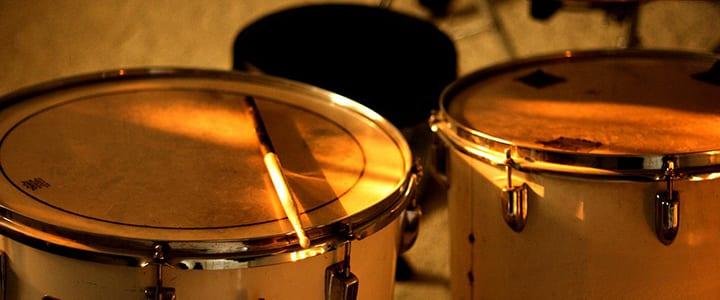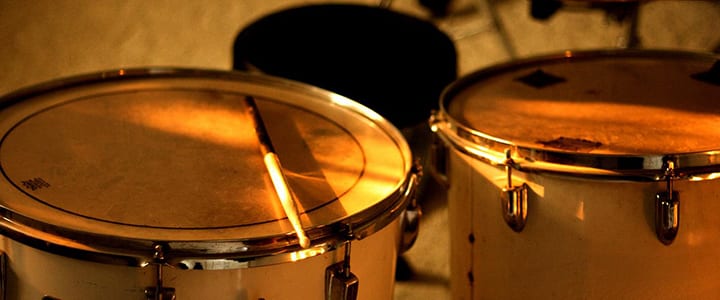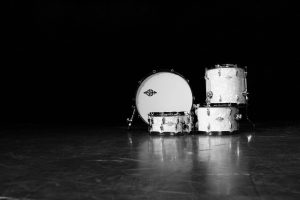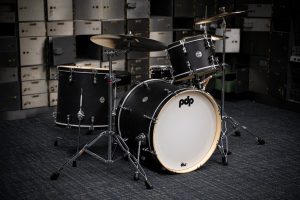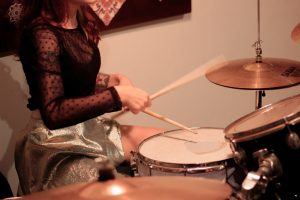Learning to play the drums means new equipment, new skills, and new terminology. Here, San Diego, CA drum teacher Maegan W. breaks down some basic drum terms so you can walk the walk and talk the talk…
Whether you’re new to the drumming world or you’re a seasoned pro, these drum terms are the ABC’s that every drummer should know.
But before you dive into the list of drum sound terms below, get some inspiration by checking out this video of drumming techniques – you’ll be grooving in no time!
What Are Some Drum Words?
1. Rudiments
Rudiments are the different drum patterns that can be used as drills themselves, or turned into music when applied properly to the drum set or drum kit.
There are several different drum rudiments, however, 40 of them have made the cut as the most important and popular rudiments to learn and use. If you want to learn all 40, Vic Firth has a guide on their website, but for now let’s take a look at some of the most basic rudiments that you will use in your drum lessons.
Before we get started, note that the letters “R” and “L” tell you which drum or hand to play. R = right hand and L = left hand.
The Single Stroke Roll
This is the most basic of all the rudiments. This is what you would naturally play if you just picked up the sticks and started playing. The pattern is R, L, R, L.
Lead with your right hand when you play this stroke, and it turns into a roll as the tempo increases.
Once you’ve learned the single stroke roll, try to play the same pattern leading with your left hand: L, R, L, R.
Double Stroke Roll
Now we get into our double strokes. The right and left hand lead will apply here as well. This is where two strokes will be played on each hand R, R, L, L (right hand lead) or L, L, R, R (left hand lead).
Double stroke rolls are sometimes called “diddles.”
Paradiddle
The paradiddle is one of the most famous and important rudiments to master. It has several variations and can be applied in so many cool ways. The pattern is R, L, R, R, L, R, L, L. The pattern is all eighth notes.
Now that you have a basic overview of the essential rudiments, let’s take a look at some other common drum terms.
2. Drum Fill
A drum fill, also called a lick or a chop, is a phrase you play to fill in space between sections of a song, or to take you and the band to the next section like the verse, chorus, or bridge.
3. Drum Throne
The seat that the drummer sits on is often referred to as the throne. Yes, just like royalty, the drummer gets a special seat.
4. Traditional and Matched Grip
These terms describe how you hold the drum sticks. In the traditional grip, you hold the left stick like a fork, and the right stick like a wand.
With a matched grip, hold both sticks like a wand with your palms facing down.
5. Groove or Beat
The drum groove or beat, is a rhythmic pattern you play to the music that keeps the time.
6. Tempo
Tempo refers to the time or speed. Sometimes drummers will use a click track or metronome to practice and work on improving their tempo. Some bands and drummers even play live shows with a click track.
Drum Terminology for Beginners from A to Z
Still not satisfied? There are countless other drum and bass terms you need to master if you want to become an expert drummer. Here are some of the most important drum terms for beginners to know, arranged in order from A to Z.
A
- Accent – this is one of the many important drum beat terms you will need to master. It has to do with placing emphasis on a certain note to give it more stress than others.
- Acoustic drums – these drum set terms refer to drums that don’t contain any electronic components and are often made of wood or synthetic material.
- Axatse – this type of drum is a gourd with beads woven around its hollow body.
B
- Backbeat – this is another one of the most important drum beat terms. It has to do with stressing betas two and four in common time.
- Ball joint – this mechanism lets a cymbal arm or tom tom arm rotate 360 degrees.
- Basket – also known as a snare drum basket, this is the cradle that keeps the snare drum in place.
- Bass drum – this is the lowest pitched drum in a marching band. When referred to in drum set terms, it is also called a kicks rum because it can be kicked with a foot pedal while you are playing.
- Bass drum pedal – this is the pedal used to operate the bass drum
- Beat displacement – this refers to moving forward all beats by one eight note.
- Beater – this is a drumstick that has a mallet-type head and is used to beat a bass drum.
- Bells – this instrument contains tuned metal bars that are mounted on rectangular frames (like marimbas, glockenspiels, or xylophones).
- Blast beats – these are single stroke rolls that alternate and are broken up between the bass drum and snare drum.
- Bodhran – this Irish drum is covered with goatskin.
- Bolero rhythm – this kind of ballad is great for dancing the bolero dance.
- Bones – also known as castanets, these are wooden instruments held in the hand and clicked together in time to a rhythm.
- Boom – this is an amr that extends from the cymbal stand to allow for greater positioning around the drumset
- Bossa nova– this is a rhythm that you can play with the drums that has origins in Brazil.
- Brekete – this kind of drum is shaped like a cylinder and can be played with a stick or the hand.
- Brushes – brushes have wire bristles and can be used for traditional jazz drumming.
C
- Cabasa – this is a Latin type of drum that has a round cylinder on a handle. It is held in one hand and rubbed in the other.
- Castanets – see bones.
- Cajon – this is a wooden box drum that sounds like a conga.
- Cha-cha – this medium-tempo rhythm has Afro-Cuban origins.
- Chimes – these small bells are brushed with the hand mallet, or drumstick to add a pleasant tone to a soft ballad.
- Chops – in drum terms and techniques, this word refers to your rhythmic vocabulary.
- Claves – these cylindrical wooden sticks are clicked together to make a high pitched sound, usually in Latin music.
- Common time – also referred to as 4/4 time and indicates four beats to the measure
- Conga – this African/Cuban drum is meant to be played with the hands
- Cowbell – this percussion instrument is frequently used in Latin music
- Crash cymbal – sometimes referred to just as crash, the crash cymbal is used to emphasize a specific beat.
- Cymbal – this copper or bronze disk is struck with a drumstick to emphasize beats and add texture to music.
D
- Djembe – this West African drum is shaped like a goblet and is one of the more common percussion instruments.
- Double bass – this drum term refers to using two bass drums in a drum set.
Downbeat – this is the main pulse as it is related to the rest of the measure.
- Drop clutch – this is a hi-hat clutch that lets the top cymbal drop whenever you hit a lever.
- Drum lessons – you can find drum lessons here to become a better drummer.
- Drum set – any set of drums with more than four or five individual pieces.
- Drumsticks – these are a pair of sticks that are to be used for drumming.
- Drum tabs – this is shorthand for writing drum tablature or sheet music.
E
- E-drums – short for electronic drums, this kind of drum is synthesized and requires electricity to operate.
- Egg shakers – these drums look like eggs and are meant to add a small amount of rhythm to a sound.
F
- Finger cymbals – these cymbals are mounted to the hand and played by striking them together
- Floor tom – this is the deepest tom that is found on a standard drum set.
- Foot pedal – this is the part of a hi-hat pedal or foot pedal that the foot is meant to rest on.
- Forte – play nice and loud!
- Free-floating – this is a term that describes a drum with hardware that is not permanently fixed to it.
G
- Ghost note – this note is meant to played extremely quietly, almost at undetectable levels
- Glockenspiel– this instrument is played with mallets and consists of tuned metal bars on a rectangular frame.
- Gourd – gourds create a zipping kind of sound that you’ll often hear in Latin music.
- Gong – this is a large suspended cymbal meant to be struck with a large mallet.
H
- Hand bells – these bells are tuned and meant to be held in the hand and shaken to produce a sound.
I
- ISS – this is short for isolation mounting system and it is how tom-toms are mounted.
J
- Jembe – these drums are the same as djembe drums, just spelled differently.
K
- Kick drum – also known as the bass drum, this is the largest drum on a set and it rests on the floor.
- Kids drums – you can even find drum sets for kids! This is one of the many drum terms used to refer to child-friendly drum sets.
L
- Latin drums – any drums that are of Afro-Cuban or Latin American culture (typically hand drums)
- Lick – also known as short drum fill or drum lick, it usually consists of a fancy beat or a quick series of notes.
- Log drum – also known as lit drum, it is played with beaters and was once carved out of old, hollowed-out trees.
M
- Mallets – mallets are specific kinds of drumsticks used to strike percussion instruments, like xylophones
- Maracas – these hollowed out gourds on sticks (like rattles) are typically filled with pebbles and can make all kinds of different sounds.
- Metronome – a clicking electronic device that sets a tempo for a song or rhythm, measuring time in beats per minute.
- Mics – short for microphone, used for micing drums
N
- Notation – this refers to music notes on sheet music
O
- Odd time – this refers to a song with an uneven or odd time signature, like 7/4.
- Orchestra bells – these are bells with tuned metal bars on a rectangular frame (generally meant to be plated with a mallet)
P
- Pans – these are large oil drums with the tops cut off, commonly used in Caribbean music, and played with mallets
- Pedal – also known as foot pedal, these are used to play the hi-hat or bass drum.
- Percussion clef – this is the staff that is commonly used in percussion instead of bass clef.
- Percussion instrument – any kind of instrument that you play by striking it with your hands or another object, like a mallet.
- Piano – this is a dynamic marking that means to play soft
- Pianissimo – this is another dynamic marking and it means to play very softly.
- Pulse – this is another one of the many drum terms that refers to the rhythm of a song – in this case, a consistent beat.
Q
- Quadruple time – this drum term refers to 4/4 time with four beats to a measure.
- Quinta – another conga drum, this one the smallest of them all.
R
- Rack toms – these are toms that are mounted to a drum set.
- Rain stick – this long, hollowed-out piece of wood is meant to mimic the sound of rain falling.
- Rhythm – combining weak and strong beats to create a syncopated, flowing pattern.
S
- Shaker – this is any kind of percussion instrument that can be shaken.
- Shell – a cylindrical drum without any heads, rims, or lugs.
- Snare drum – the snare drum is one of the most commonly used drums in marching bands.
- Steel drum – these drums are common in the Caribbean Islands and played with mallets.
T
- Talking drum – an hourglass-shaped drum, this one is found in West Africa.
- Tempo – this drum term refers to the rhyme or speed of a song.
- Timpani – also known as kettle drums, these pitched instruments are large drums made of brass or copper.
- Triplet – this is a rhythm with a group of three per beat.
U
- Udu – the word udu means pot, but in the world of drum terms, it refers to a large, oblong drum made out of clay.
V
- Vibes – also known as vibraphone, this is an instrument similar to the xylophone.
- Vibraslap – this is a percussion instrument that is used for sound effect.
W
- Wing nut – this is used at the top of the cymbal stands to secure the cymbal.
- World drumming – this is one of the many drum terms used to refer to drumming that incorporates rhythms from around the world.
X
- X-hat – these are sets of hi-hats positioned remotely on the drumset.
- Xylophone – also known as the bells these contain metal or wooden bars that are then played with mallets, often in orchestras or symphonies.
Y
- YÉ-YÉ – a style of pop drumming that originated in France in the 1960s.
Z
- Zero ring – this is a ring that is thin and made out of plastic, placed around the drums’ parameters to control resonance and undesired tones.
Drum Words and Phrases – The List of Drum Terms is Endless!
As you can see, the list of drum terms goes on and on, and you will discover a lot more as you continue your drum lessons. If you ever hear a new term that you don’t understand, don’t be afraid to ask someone what it means. You may feel silly at first, but it’s the best way to learn and increase your drum vocabulary.
I hope you enjoyed this and learned a few terms that you can use. Keep on shredding, that means playing drums like crazy!
Want to learn more drum terms and techniques? Sign up with a private drum instructor today!
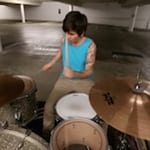 Maegan W. teaches drums, songwriting, and more in San Diego, CA. She earned a degree in Percussion from the Musician’s Institute, and has been teaching private lessons since 2004. Learn more about Maegan here!
Maegan W. teaches drums, songwriting, and more in San Diego, CA. She earned a degree in Percussion from the Musician’s Institute, and has been teaching private lessons since 2004. Learn more about Maegan here!
Suzy S.
